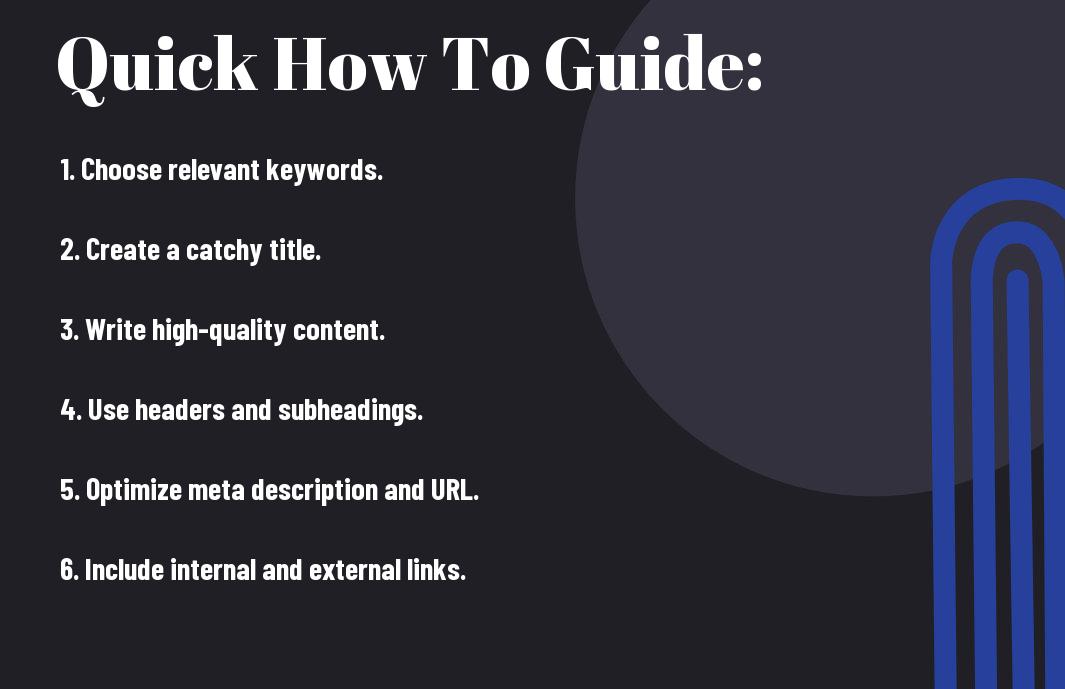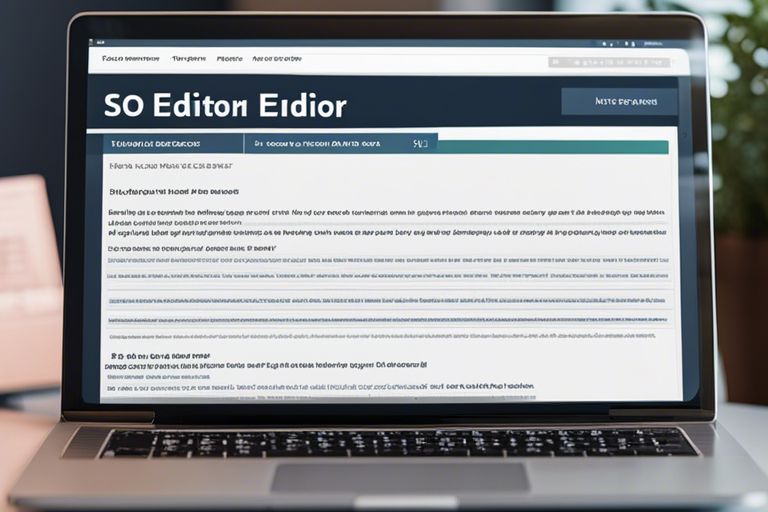Optimization of your blog post for search engines is crucial to increase visibility and drive traffic to your website. By following these simple steps, you can ensure that your content is not only engaging but also optimized for SEO. From conducting keyword research to creating a compelling title and meta description, you’ll learn how to create blog posts that rank higher in search engine results pages. Let’s dive in and elevate your blogging game!
Understanding SEO Fundamentals
What is SEO and Why is it Important for Blogging?
If you want your blog to be easily found online and reach a larger audience, understanding SEO is crucial. SEO, or Search Engine Optimization, is the practice of improving your website’s visibility on search engine results pages (SERPs). By optimizing your content for search engines, you can increase organic traffic to your blog and attract more readers. When you implement SEO strategies effectively, you can improve your blog’s ranking on search engines like Google, making it easier for people to discover your content.
How Search Engines Work and Index Content
There’s a complex process that search engines like Google use to crawl and index websites. When you publish a new blog post, search engine bots crawl your website to analyze the content. They then index this content in their database, which is used to provide relevant results to users when they search for information online. By understanding how search engines work and index content, you can optimize your blog posts to make them more visible to search engines and improve your chances of ranking higher in search results.
Blogging regularly and creating high-quality, relevant content is vital for improving your blog’s visibility on search engines. By publishing informative articles, using relevant keywords, and following SEO best practices, you can increase your chances of ranking higher in search engine results and driving more traffic to your blog. Remember to focus on creating valuable content that resonates with your audience while also optimizing it for search engines to maximize your blog’s reach and impact.

Keyword Research and Planning
Tips for Conducting Effective Keyword Research
Little do you know that keyword research is a crucial step in optimizing your blog post for SEO. Before you start writing, it’s important to identify the keywords that your target audience is using to search for information related to your topic. Start by brainstorming a list of potential keywords that are relevant to your content.
- Use keyword research tools like Google Keyword Planner, SEMrush, or Ahrefs to discover popular keywords and long-tail variations that have high search volume and low competition.
- Look at what keywords your competitors are using and consider incorporating them into your content strategy.
Assume that you need a good mix of short-tail and long-tail keywords to attract a wide range of search queries and drive traffic to your blog.
How to Identify Relevant Long-Tail Keywords for Your Blog Post
You may not be aware, but long-tail keywords are longer, more specific keyword phrases that visitors are more likely to use when they’re closer to a point-of-purchase or when they’re using voice search. By targeting these long-tail keywords, you can boost your chances of ranking higher in search engine results and attracting qualified leads to your blog.
Blog posts that incorporate long-tail keywords tend to have higher conversion rates because they are more targeted and address specific user queries. For example, instead of targeting the keyword “running shoes,” you could focus on a long-tail keyword like “best running shoes for flat feet” to attract a more specific audience segment.
Tips
When identifying long-tail keywords for your blog post, consider using question-based keywords that begin with who, what, where, when, why, or how. These keywords are more likely to match the natural language queries that users type into search engines.
Crafting a Compelling Title
Factors that Make a Title SEO-Friendly
On your quest to write a blog post that ranks well on search engines, the title plays a crucial role. There are several factors that make a title SEO-friendly, such as incorporating relevant keywords that people are likely to use when searching for content like yours. Including numbers, power words, and creating a sense of urgency can also attract more clicks to your post.
- Use relevant keywords
- Incorporate numbers
- Utilize power words
- Create a sense of urgency
Assume that you want to rank for the keyword “best chocolate cake recipe,” incorporating this exact phrase or variations of it in your title can greatly improve your chances of showing up in search results.
How to Write a Title that Grabs Reader Attention
that On top of being SEO-friendly, your title should also grab the reader’s attention and make them curious to click and read more. Crafting a title that is clear, concise, and directly addresses a pain point or desire of your target audience can significantly increase engagement. Using strong verbs, posing a question, or teasing a solution can all make your title more enticing.
Another tip to consider is to keep your title within the ideal length for search engines, typically around 50-60 characters to ensure that it displays properly in search results and doesn’t get cut off.
Writing Engaging and Informative Content
Many aspects contribute to the success of your blog post, but one of the most critical elements is the content itself. High-quality, relevant, and valuable content is key to keeping your readers engaged and coming back for more.
How to Create High-Quality, Relevant, and Valuable Content
Valuable content is informative, engaging, and adds value to your reader’s experience. To create such content, you should start by understanding your audience and their needs. Conduct research to identify trending topics in your niche, and tailor your content to address these interests.
Tips for Structuring Your Content for Readability and SEO
Assuming that you want your content to rank well on search engines and be easy to read for your audience, structuring your posts is crucial. Break up your content into sections with clear headings and subheadings to make it more scannable for readers and search engines.
- Use bullet points or numbered lists to organize your information.
- Include relevant keywords naturally throughout your content.
- Utilize engaging images and multimedia to break up text and enhance the visual appeal.
Perceiving your content in this way not only improves readability but also boosts your SEO efforts, making it more likely for search engines to recognize and rank your content for relevant queries.
Another Tip for Structuring Your Content for Readability and SEO
Assuming you want to keep your readers engaged from start to finish, incorporate storytelling elements, and keep your paragraphs short and concise. This approach helps maintain your reader’s interest and ensures they can easily digest the information you are providing.
- Use subheadings to break up long blocks of text and guide your readers through the content.
- Include a clear call-to-action at the end of your post to encourage further engagement with your site.
Optimizing Your Meta Description
The Importance of Meta Descriptions in SEO
Now, let’s talk about the importance of meta descriptions in SEO. While meta descriptions do not directly impact your search engine rankings, they play a crucial role in attracting visitors to your website. A well-crafted meta description can make your link stand out in search engine results and entice users to click on it. By summarizing the content of your blog post in a concise and compelling way, you can increase the chances of getting more clicks and traffic to your site.
How to Write a Meta Description that Increases Click-Through Rates
Little details in your meta description can make a big difference in click-through rates. When crafting your meta description, make sure to include relevant keywords that you want to rank for. Keep it between 150-160 characters to ensure that it fully shows up in search engine results. Use active language and a strong call-to-action to encourage users to click on your link. Additionally, make sure the meta description accurately reflects the content of your blog post to set the right expectations for the readers.
Another tip to increase click-through rates is to make your meta description unique and compelling. Avoid using generic descriptions and instead, highlight what makes your blog post valuable and worth clicking on. By customizing your meta description for each blog post and making it engaging, you can attract more visitors to your website and improve your overall SEO performance.
Using Header Tags Effectively
What are Header Tags and How Do They Impact SEO?
There’s a range of header tags in HTML – h1, h2, h3, etc. These tags are used to define headings and subheadings on a webpage. They are not just for formatting purposes; they also play a crucial role in SEO. Header tags provide structure to your content, making it easier for both users and search engines to understand the hierarchy and relevance of the information on your page.
How to Use Header Tags to Organize and Highlight Your Content
For effective SEO, you need to use header tags strategically throughout your blog post. Start with a single h1 tag for the main title of your post. Then, use h2 tags for major sections or key points within the content. You can further divide these sections with h3 tags to provide more structure and organization. By using header tags in this way, you are not only making your content more readable and engaging for your audience but also signaling to search engines what the most important topics on your page are.
This helps search engines better understand the context of your content and can improve your chances of ranking higher in search results for relevant keywords. Remember to include your target keywords in your header tags to further optimize your content for SEO.
Image Optimization for SEO
Why Image Optimization Matters for Blog Posts
Despite what some may think, images are actually crucial for SEO and can have a significant impact on your blog post’s performance. Search engines not only crawl and index the text on your page but also the content of your images. By optimizing your images, you can improve your chances of ranking higher in image search results and driving more organic traffic to your blog.
Tips for Optimizing Your Images for Search Engines
Some key tips for optimizing your images for search engines include using descriptive filenames and alt text, choosing the right file format and size, and adding relevant captions. By following these best practices, you can make your images more discoverable and accessible to both search engines and users.
- Use descriptive filenames and alt text to provide context for your images
- Choose the right file format and size to ensure fast loading times and better user experience
- Add relevant captions to further optimize your images for search engines
With image optimization being an important part of SEO, it’s important to pay attention to the details when adding images to your blog posts. Any effort you put into optimizing your images can have a positive impact on your overall search engine visibility and rankings.
- Ensure your images are relevant to your content and enhance the user experience
- Compress your images to reduce file size without compromising quality for faster loading times
It is crucial to keep in mind that search engines cannot ‘see’ images like humans do, so providing descriptive information through filenames, alt text, and captions is important for them to understand the context and relevance of your images in relation to your blog content. By following these image optimization tips, you can effectively improve your blog’s SEO performance and increase your chances of reaching a wider audience online.

Internal and External Linking Strategies
How to Use Internal Linking to Improve User Experience and SEO
Little did you know that internal linking is not just about directing users to other pages within your website, it also plays a crucial role in improving your site’s SEO. By strategically linking relevant pages together, you can guide your visitors to more valuable content, reduce bounce rates, and increase the time they spend on your site. This not only enhances user experience but also helps search engine crawlers navigate and index your site more effectively.
The Role of External Linking in Establishing Authority and Credibility
Assuming you want to establish authority and credibility in your industry, external linking is key. By linking out to reputable sources and relevant websites, you show your audience and search engines that you have done your research and are providing valuable information. This not only helps build trust with your readers but also signals to search engines that your content is well-supported and reliable.
Internal linking ensures that your website is well-connected internally, making it easier for users and search engines to navigate through your content seamlessly. By strategically placing internal links within your content, you can guide users to related articles, product pages, or resources that can enhance their overall experience on your website.
Content Length and Quality Guidelines
How to Determine the Ideal Length for Your Blog Post
Despite the constant changes in search engine algorithms, one thing remains consistent – longer content tends to perform better in terms of SEO. The ideal length for your blog post can vary depending on the topic and your target audience. A good rule of thumb is to aim for at least 1000 words per post, but in some cases, longer articles of 2000 words or more may be more beneficial for SEO.
Quality content trumps quantity when it comes to blog posts. The length of your post should ultimately be determined by the depth of information you provide and how well you address the topic. Recall, your goal is to engage readers and provide them with valuable information that keeps them on your page.
Factors that Contribute to High-Quality Content
There’s more to quality content than just word count. Several factors contribute to creating high-quality blog posts that are not only SEO-friendly but also resonate with your audience. When crafting your content, consider factors such as relevance, accuracy, and uniqueness. Make sure your content is relevant to your target audience and provides accurate information.
- Use proper grammar and spelling to enhance readability
- Include visuals like images and videos to break up text and engage readers
Another important factor in creating high-quality content is the use of proper formatting. Break up your content into easy-to-read paragraphs, use headings and subheadings to organize your thoughts, and incorporate bullet points or numbered lists to highlight key points. These formatting techniques not only improve readability but also make your content more SEO-friendly.
- Ensure your content is easy to scan and navigate
SEO-Friendly Formatting and Typography
Your blog post’s formatting and typography play a crucial role in attracting readers and improving SEO. To learn more about writing SEO-friendly blogs, check out How to Write SEO Friendly Blogs.
How to Use Formatting to Enhance Readability and SEO
One way to make your blog post reader-friendly and SEO-friendly is by using proper formatting. Break up your content into smaller paragraphs to make it easier for readers to digest. Utilize headings (H1, H2, etc.) to structure your post and use bulleted lists to highlight key points. These formatting techniques not only improve readability but also help search engines understand the structure of your content, ultimately boosting your SEO efforts.
Tips for Choosing Typography that Improves User Experience
Tips for choosing the right typography include selecting fonts that are easy to read on all devices and sizes. Utilize a mix of font styles, such as sans-serif for body text and serif fonts for headings, to create visual interest. Additionally, consider the line spacing and line length to ensure your content is easy to navigate. Knowing the importance of typography in user experience can significantly impact how readers engage with your blog content.
- Choosing readable fonts is important for enhancing user experience
- Consistent typography across your blog helps in brand recognition

Mobile-Friendliness and Page Speed
The Importance of Mobile-Friendliness in Modern SEO
Not optimizing your blog post for mobile-friendliness can significantly impact your SEO ranking. With the increasing use of mobile devices to access websites, search engines like Google prioritize mobile-friendly websites in their search results. If your blog post is not optimized for mobile, you risk losing out on valuable traffic and potential readers.
Some key elements of mobile-friendliness include responsive design, readable text without zooming, and easy navigation. By ensuring your blog post is mobile-friendly, you create a better user experience for your audience, leading to higher engagement and improved ranking on search engine results pages.
How to Optimize Your Blog Post for Page Speed
If you want to improve your blog post’s SEO performance, optimizing for page speed is crucial. Search engines like Google consider page speed as a ranking factor, so a faster loading time can help boost your search visibility. By optimizing your blog post for speed, you enhance user experience and decrease bounce rates, which can positively impact your SEO efforts.
Speed up your blog post by optimizing images, enabling browser caching, minifying CSS and JavaScript files, and leveraging browser compression. These techniques can help your page load more quickly, providing a smoother experience for your readers and improving your chances of ranking higher in search results.
Content Promotion and Outreach Strategies
All SEO efforts can go to waste if you don’t promote your content effectively. After following the steps outlined in the previous chapters of this guide on How to write SEO-friendly blog posts that rank (in 8 steps), it’s time to focus on getting your blog post in front of as many eyes as possible.
How to Promote Your Blog Post on Social Media and Beyond
Assuming you have created valuable and optimized content, your next step is to share it across all your social media channels. Craft catchy headlines, use relevant hashtags, and don’t forget to engage with your audience by responding to comments and messages. Additionally, consider reaching out to influencers or industry thought leaders to see if they can share your content with their followers. Utilize email marketing to notify your subscribers about your new post and consider guest posting on relevant websites to increase your reach.
Tips for Building Relationships and Collaborating with Other Bloggers
Assuming you want to expand your network and reach a broader audience, collaborating with other bloggers can be highly beneficial. Start by engaging with their content through comments and social media shares. Reach out to them with a personalized pitch for collaboration, such as co-authoring a post or hosting a joint webinar. Building relationships in the blogging community can lead to valuable partnerships, guest posting opportunities, and increased exposure for your blog.
- Engage with other bloggers’ content through comments and social media shares.
- Reach out with personalized pitches for collaboration opportunities.
Other bloggers in your niche can be valuable allies in your blogging journey. Not only can they provide support and advice, but they can also help you reach new audiences and improve your credibility within the industry. Building strong relationships with other bloggers can lead to exciting collaborations, joint projects, and increased visibility for your blog and brand.
- Don’t hesitate to ask for feedback and offer help in return.
- Thou shall reciprocate any favors or support received from other bloggers.
Plus, by collaborating with other bloggers, you can tap into each other’s expertise and knowledge, creating more insightful and engaging content for your readers. Working together can also open up opportunities for cross-promotion and shared resources, ultimately benefiting both parties in the long run.
Tracking and Analyzing Your Results
How to Set Up and Track Key SEO Metrics
Unlike other forms of marketing, one of the advantages of SEO is the ability to track and measure your results easily. Setting up key SEO metrics involves identifying the most important performance indicators for your website and implementing tools like Google Analytics to track them. Little by little, you can monitor metrics such as organic traffic, keyword rankings, backlinks, and conversions to understand the impact of your SEO efforts.
Tips for Analyzing Your Results and Refining Your Strategy
Little by little, you should analyze the data gathered from tracking your SEO metrics to refine your strategy. Look for patterns in your data to identify what is working and what needs improvement. By regularly reviewing your results, you can make data-driven decisions to optimize your content, keywords, and overall SEO approach for better performance.
- Identify trends and patterns in your data
- Monitor changes in search engine algorithms
- Experiment with different SEO strategies to see what works best
For instance, you may notice that certain keywords are driving more traffic to your site, while others are not performing as well. By analyzing this data, you can adjust your keyword strategy to focus on those that are more effective. After all, the key to successful SEO is continuous monitoring, analysis, and adaptation based on your results.
Summing up
Considering all points, writing a blog post for SEO requires careful planning and execution. By focusing on relevant keywords, creating high-quality content, and optimizing your post for search engines, you can improve your blog’s visibility and attract more readers. Remember to engage with your audience, promote your post on social media, and monitor its performance to continually optimize your SEO strategy.

